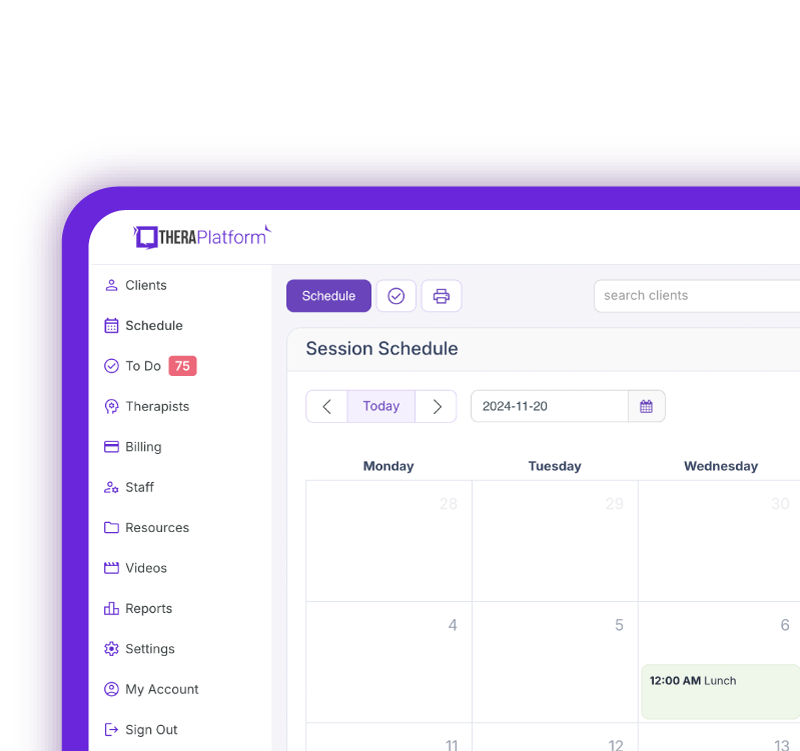Maximizing billing efficiencies for group practices

When it comes to billing in group therapy practices, efficiency and accuracy are vital for maintaining a sustainable and thriving business.Billing processes, however, can trip up even the most seasoned administrators and therapists. Documentation requirements, coding standards, and complex insurance regulations can be confusing and overwhelming.
Summary
- Streamlining billing processes in group therapy practices helps reduce errors, maximize revenue, and maintain compliance with insurance regulations.
- Using EHR systems and billing software can automate tasks like claims submission, invoicing, and payment tracking, saving therapists time and improving accuracy.
- Establishing well-defined billing policies, including payment terms and dispute resolution, helps prevent misunderstandings and enhances client satisfaction. Enrolling in an insurance billing course for therapists can help providers enhance their knowledge.
- Regular staff training on insurance updates and billing procedures, along with consistent
Streamline your insurance billing with One EHR
- Claim batching
- Auto claims
- Automated EOB & ERA
- Real-time claim validation
- Real-time claim tracking
- Aging and other reports

Follow this guide to learn actionable tips for improving billing practices, reducing errors, and maximizing revenue.
Understanding billing procedures in group therapy practices
Billing in group therapy practices typically involves several key steps, including:
- Eligibility determination: Verify insurance coverage and obtain necessary authorizations for therapy services.
- Invoicing: Invoices for clients or insurance providers are generated.
- Claims submissions: Electronic or paper forms are used to submit claims to insurance payers.
- Follow up: Monitoring claims status, ensuring timely reimbursement, and addressing denials or appeals.
Group therapy practices must comply with insurance regulations and codes to successfully bill and obtain service reimbursement. Electronic health records (EHR) and billing software can automate specific tasks and ensure data accuracy, streamlining billing procedures.
→ Click here to enroll in our free on-demand Insurance Billing for Therapists video course [Enroll Now]
Establishing clear billing policies and procedures
Clear billing policies and procedures can help group therapy practices avoid client disputes and misunderstandings.
Your practice can clearly outline the following:
- Payment terms: Define terms for payment, insurance coverage, and client responsibilities.
- Policy for handling disputes: Establish protocols for addressing billing disputes and inquiries.
- Maintain transparency: Help clients understand the billing process and provide a way for them to access statements easily.
Ensuring these clear policies may facilitate client satisfaction and minimize billing process confusion.
Watch this video to learn common insurance billing struggles and solutions
→ Start My Free Trial
→ Start My Free Trial
Streamlining documentation processes
Thorough and accurate documentation is critical for supporting billing claims, reducing errors, and avoiding payment denials. Here are a few tips for efficient note-taking during group therapy sessions:
- Use a template: Standardized templates ensure that therapy notes contain all necessary information. Download common notes templates here.
- Be specific: Include detailed descriptions of a client's medical diagnosis, treatment diagnosis, progress, and the services they're being provided.
- Utilize an EHR system: EHR software can be leveraged to reduce errors associated with manual data entry and to streamline documentation.
Using these standard procedures can help save therapists' time and increase billing accuracy.
Practice Management + EHR + Telehealth
Manage more in less time in your practice with TheraPlatform

Training staff on billing procedures
Training staff in billing procedures and compliance is essential for verifying their understanding and ensuring accuracy.
Consider educating staff about insurance regulations and updates on coding changes. Role-playing scenarios allow staff to practice billing interactions with clients and further develop their skills.
Staff training can reduce errors and improve billing capabilities, benefiting the group practice's financial health.
Utilizing technology for efficient billing
Explore and embrace technology to facilitate efficient billing within your group therapy practice.
Explore features of billing software that is tailored specifically for therapy practices. This software often offers helpful features such as automated claims submission, payment tracking, and the ability to generate reports.
Automating billing processes can minimize errors associated with manual entry. Scheduling automatic billing reminders and payment processing gives therapists more time to focus on direct client care.
Billing software can be integrated with EHR systems to ensure client data flows seamlessly between documentation and billing, improving accuracy and reducing time spent duplicating information.
Monitoring and reviewing billing practices
Monitoring and reviewing billing practices on an ongoing basis helps ensure that your processes continue to be effective and allows you to identify areas for improvement.
Establish regular audits of your billing processes and documentation. Audit billing assesses accuracy and compliance. Therapists can implement the necessary changes to improve overall accuracy.
Identify common billing errors and address them proactively. Errors such as missing information and incorrect coding can lead to claim denials. Therapy practices can proactively improve their billing process and minimize revenue loss by addressing these issues.
Seek feedback from staff and clients to help identify areas of improvement within billing procedures. This input can provide valuable insights and enhance overall client satisfaction.
Maintaining compliance with regulatory standards
Staying updated on changes to insurance regulations and billing codes is essential for maintaining compliance. To keep therapists and practice owners informed, consider subscribing to regular newsletters or referring to your professional organization.
Ensuring compliance with HIPAA regulations is critical for protecting patient privacy and maintaining sufficient security. Implement secure practices for handling patient information throughout billing procedures.
Consulting with legal or financial professionals can provide therapists with guidance to help them efficiently navigate compliance issues.
Free Resources for Therapists
Click below and help yourself to peer-created resources:

Handling denied claims and revenue cycle management
Maximize reimbursement through effective management of denied claims and billing discrepancies. Consider using these strategies:
Develop a process for appealing denials. Claim denials happen and can impact the practice's financial health. Have a clear strategy for appealing denials, including using detailed supporting documentation from therapists.
Establish effective revenue cycle management. Streamline the revenue cycle process to ensure efficient and accurate billing procedures from start to finish.
Optimize reimbursement processes. Regularly review reimbursement rates and negotiate with payers when necessary to enhance service profitability and minimize revenue loss.
Focusing on denial management and ways to optimize the revenue cycle can help therapy practices enhance their overall financial performance.
Optimizing billing practices in group therapy settings can maximize revenue and improve the efficiency of billing processes.
Consider implementing key strategies outlined in this guide to positively benefit your practice and clients:
- Prioritize efficiency and accuracy within billing procedures to avoid delays and errors.
- Stay informed on current coding standards and changes to insurance regulations.
- Leverage technology to improve efficiency by streamlining billing processes.
- Seek professional legal or financial guidance on compliance issues.
Free Resources for Therapists
Click below and help yourself to peer-created resources:

How EHR and practice management software can save you time with insurance billing for therapists
EHRs with integrated billing software and clearing houses, such as TheraPlatform, offer therapists significant advantages in creating an efficient insurance billing process. The key is minimizing the amount of time dedicated to developing, sending, and tracking medical claims through features such as automation and batching.
What are automation and batching?
- Automation refers to setting up software to perform tasks with limited human interaction.
- Batching or performing administrative tasks in blocks of time at once allows you to perform a task from a single entry point with less clicking.
Which billing and medical claim tasks can be automated and batched through billing software?
- Invoices: Create multiple invoices for multiple clients with a click or two of a button or set up auto-invoice creation, and the software will automatically create invoices for you at the preferred time. You can even have the system automatically send invoices to your clients.
- Credit card processing: Charge multiple clients with a click of a button or set up auto credit card billing, and the billing software will automatically charge the card (easier than swiping!)
- Email payment reminders: Never manually send another reminder email for payment again, or skip this altogether by enabling auto credit card charges.
- Automated claim creation and submission: Batch multiple claims with one button click or turn auto claim creation and submission on.
- Live claim validation: The system reviews each claim to catch any human errors before submission, saving you time and reducing rejected claims.
- Automated payment posting: Streamline posting procedures for paid medical claims with ERA. When insurance offers ERA, all their payments will post automatically on TheraPlatform's EHR.
- Tracking: Track payment and profits, including aging invoices, overdue invoices, transactions, billed services, service providers.
Utilizing billing software integrated with an EHR and practice management software can make storing and sharing billing and insurance easy and save providers time when it comes to insurance billing for therapists.
Streamline your practice with One EHR
- Scheduling
- Flexible notes
- Template library
- Billing & payments
- Insurance claims
- Client portal
- Telehealth
- E-fax

Resources
TheraPlatform is an all-in-one EHR, practice management, and teletherapy software built for therapists to help them save time on admin tasks. It offers a 30-day risk-free trial with no credit card required and supports mental and behavioral health, SLPs, OTs, and PTs in group and solo practices.
More resources
- Therapy resources and worksheets
- Therapy private practice courses
- Ultimate teletherapy ebook
- The Ultimate Insurance Billing Guide for Therapists
- The Ultimate Guide to Starting a Private Therapy Practice
- Insurance billing 101
- Practice management tools
Free video classes
- Free on-demand insurance billing for therapist course
- Free mini video lessons to enhance your private practice
- 9 Admin tasks to automate in your private practice
References
Burks, K., Shields, J., Evans, J., Plumley, J., Gerlach, J., & Flesher, S. (2022). A systematic review of outpatient billing practices. SAGE Open Medicine, 10, 20503121221099021. DOI: https://doi.org/10.1177/20503121221099021 .
Osagie, O. E., Emeka, O. F., & Beatrice, E. (2023). Outsourcing benefits and complications. BW Academic Journal, 9-9. DOI: https://bwjournal.org/index.php/bsjournal/article/view/1363 .
Temel, S., & Durst, S. (2021). Knowledge risk prevention strategies for handling new technological innovations in small businesses. VINE journal of information and knowledge management systems, 51(4), 655-673. DOI: https://www.emerald.com/insight/content/doi/10.1108/VJIKMS-10-2019-0155/full/html.



